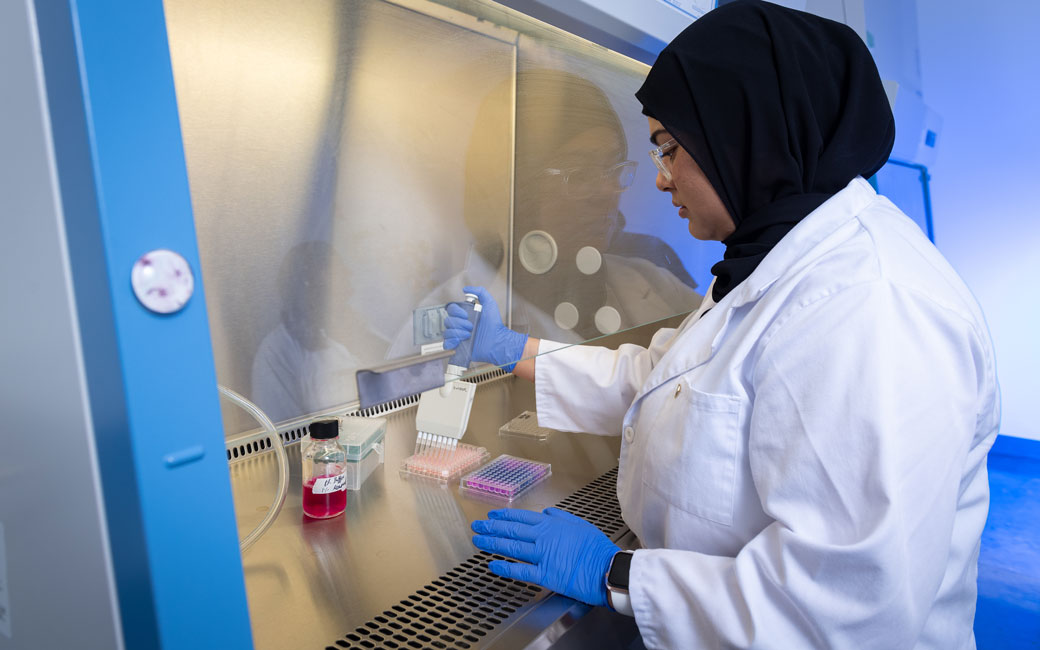TU’s biology department provides biomedical research opportunities
Bridges to the Doctorate student Mehnaz Falguni ′22 has built confidence in her research skills and is making an impact in the field of septic shock.
By Kyle Hobstetter on May 15, 2023

Mehnaz Falguni has always had a passion for science. So much so, she jokes, there is something wrong with her.
“I loved [watching] cells undergoing apoptosis under the microscope and all other biological functions—they were just beautiful,” says Falguni ′22. “It’s so organic. It’s natural and scientific art.”
This passion for biology led her to transfer to TU from Harford Community College and earn a bachelor’s degree in cell and molecular biology. She was then selected for TU’s biology graduate program as a trainee in the highly competitive Bridges to the Doctorate Program (B2D).
This program is funded by a grant from the National Institute of General Medical Sciences (NIGMS), and supports three to four students per year who complete a master’s degree in biology at TU before moving on to earn a doctorate at University of Maryland School of Medicine or another institution.
Most importantly, following her passion led to a research opportunity to work in the lab of biology department assistant professor Erin Harberts, and the ability to conduct the translational biomedical research that she envisions herself doing as a career.
“Mehnaz has an inherent positive energy that is tangible,” Harberts says. “I’m so grateful to have a graduate student with such high levels of focus and enthusiasm in the lab. I can’t always be there, but knowing she’s there makes me feel confident that a productive and encouraging research environment is being maintained.”
“I am lucky to have a mentor like Dr. Harberts,” says Falguni. “She’s always there to support and listen to me. Honestly, she is my wise mentor, protective sister and my cheerleader all in one.”

Falguni has been assisting Harberts for more than a year and has helped with the professor’s studies on the interaction of microbial ligands with innate immune receptors.
One of Falguni’s key responsibilities has been to follow up on one of Harberts’ manuscripts that looks at non-classic responses to septic shock and how they can help improve survival rates for those who contract a secondary infection.
“There are many already well-defined responses to septic shock, and if a patient is able to survive septic shock, which is a feat itself, they become extremely immune ataxic—meaning they don’t have a very high immune response capacity,” Falguni says. “These patients still acquire secondary infections and often die. We are investigating what types of immune responses might be activated, even in the absence of the classic immune response.”
After studying this research question for over a year now, Falguni has a well-established hypothesis about an alternative inflammatory mechanism that is activated in recovered sepsis patients that have acquired a secondary infection.
Falguni has participated in multiple symposiums and national conferences. Most recently, she presented her project titled “TLR4-Independent Mechanisms of Complement Activation During Endotoxemia” in a poster session at The Mid-Atlantic Microbial Pathogenesis Meeting (MAMPM).
“I absolutely love presenting and talking about my research,” says Falguni. “Having opportunities to explain my work not only conveys the importance of our research to people, it also helps me to see my science from different perspectives. I also get to make valuable connections and have fruitful conversations with intellectuals from various institutions, which is amazing.”
While she enjoys her experience as a graduate student, she mentions that all this would not be possible without her amazing support system. “I am so thankful for the relentless support from my family, friends, professors and labmates. I would also not be able to confidently conduct my experiments without the support from Fisher College of Science and Mathematics. It was empowering to have a grant application accepted and my research funded.”